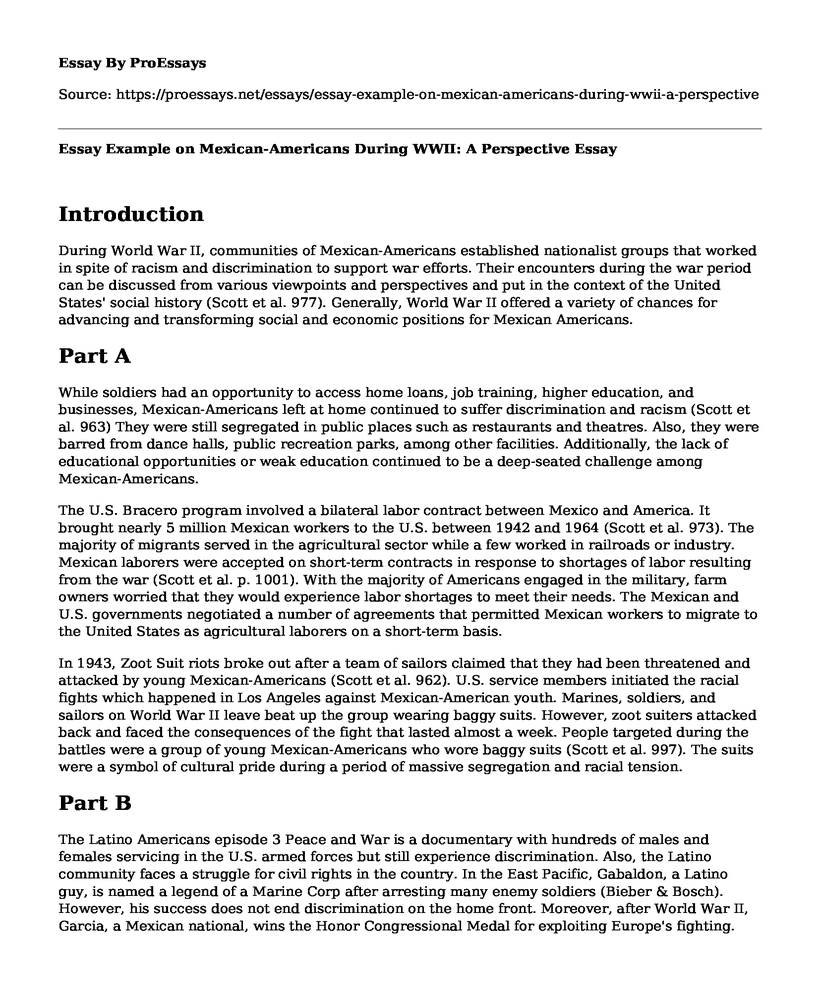Introduction
During World War II, communities of Mexican-Americans established nationalist groups that worked in spite of racism and discrimination to support war efforts. Their encounters during the war period can be discussed from various viewpoints and perspectives and put in the context of the United States' social history (Scott et al. 977). Generally, World War II offered a variety of chances for advancing and transforming social and economic positions for Mexican Americans.
Part A
While soldiers had an opportunity to access home loans, job training, higher education, and businesses, Mexican-Americans left at home continued to suffer discrimination and racism (Scott et al. 963) They were still segregated in public places such as restaurants and theatres. Also, they were barred from dance halls, public recreation parks, among other facilities. Additionally, the lack of educational opportunities or weak education continued to be a deep-seated challenge among Mexican-Americans.
The U.S. Bracero program involved a bilateral labor contract between Mexico and America. It brought nearly 5 million Mexican workers to the U.S. between 1942 and 1964 (Scott et al. 973). The majority of migrants served in the agricultural sector while a few worked in railroads or industry. Mexican laborers were accepted on short-term contracts in response to shortages of labor resulting from the war (Scott et al. p. 1001). With the majority of Americans engaged in the military, farm owners worried that they would experience labor shortages to meet their needs. The Mexican and U.S. governments negotiated a number of agreements that permitted Mexican workers to migrate to the United States as agricultural laborers on a short-term basis.
In 1943, Zoot Suit riots broke out after a team of sailors claimed that they had been threatened and attacked by young Mexican-Americans (Scott et al. 962). U.S. service members initiated the racial fights which happened in Los Angeles against Mexican-American youth. Marines, soldiers, and sailors on World War II leave beat up the group wearing baggy suits. However, zoot suiters attacked back and faced the consequences of the fight that lasted almost a week. People targeted during the battles were a group of young Mexican-Americans who wore baggy suits (Scott et al. 997). The suits were a symbol of cultural pride during a period of massive segregation and racial tension.
Part B
The Latino Americans episode 3 Peace and War is a documentary with hundreds of males and females servicing in the U.S. armed forces but still experience discrimination. Also, the Latino community faces a struggle for civil rights in the country. In the East Pacific, Gabaldon, a Latino guy, is named a legend of a Marine Corp after arresting many enemy soldiers (Bieber & Bosch). However, his success does not end discrimination on the home front. Moreover, after World War II, Garcia, a Mexican national, wins the Honor Congressional Medal for exploiting Europe's fighting. However, the guy is denied service in a diner held in Texas.
The encounter during the war period forces Latinos to fight and demand civil rights back home. The U.S. GL Forum is arranged by Dr. Hector Garcia, who transforms himself into a committed and tireless civil rights advocate. Even if Latinos establish significant benefits, the equality journey is far from over. Latino Americans series is the first main documentary to chronicle varied Latino challenges and history and the rich. The group has assisted shape the U.S. over the previous 500-plus years and have had the largest minority group with over 50 million people.
Conclusion
From the analysis Mexican Americans served a commendable role in World War II, involving in every major war that the country fought. They found their involvement in the wars necessary not only as an act of patriotism but also as an assailable proof that they were citizens of the country who needed to be treated with respect without any form of discrimination or prejudice. For this, WWII offered the ethnic group which a chance to transform their social and economic stance, integrating them into the holistic American system.
Works Cited
P. Scott Corbett, Volker Janssen, Fullerton, John M. Lund, Todd Pfannestiel, Sylvie Waskiewicz, Paul Vickery. The US History. 13, Jan. 2020. 956-1006. https://openstax.org/details/books/us-history?Book%20details
Bieber, J., and A. Bosch. "Episode 3: War and Peace." PBS.org, 1 Oct. 2013, www.pbs.org/video/latino-americans-episode-3-war-and-peace/.
Cite this page
Essay Example on Mexican-Americans During WWII: A Perspective. (2023, Aug 08). Retrieved from https://proessays.net/essays/essay-example-on-mexican-americans-during-wwii-a-perspective
If you are the original author of this essay and no longer wish to have it published on the ProEssays website, please click below to request its removal:
- Communication With Stakeholder's Essay
- Military Personnel Make Great Assets in the Business World Essay Example
- Essay Sample on Unleashing the Power of Social Movements: Types, Strategies & Theories
- Essay Example on Colonists of Jamestown: Incorporation of the Guild System
- Essay Example on Healthy Competition: Benefits, Types, & Customer Relationships
- Essay Example on Effective Communication: The Key to Success in Organizations
- Paper Sample on Bible's Approach to Human Rights: Women, Slavery, Minorities







